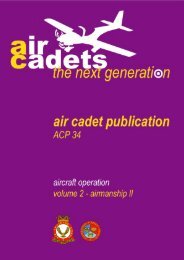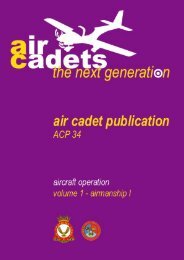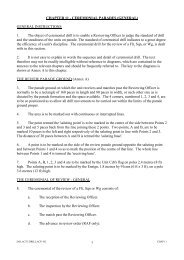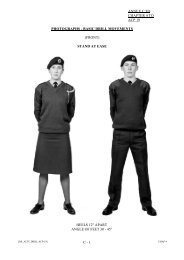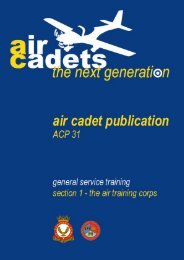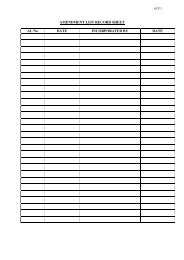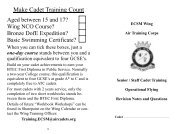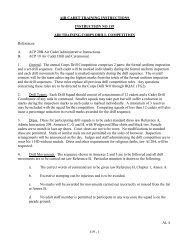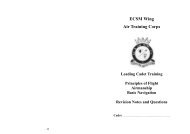Create successful ePaper yourself
Turn your PDF publications into a flip-book with our unique Google optimized e-Paper software.
BASIC FOOT DRILL<br />
CHAPTER 3 - FOOT DRILL<br />
1. During the initial stages of training in foot drill, instruction is to be given in open order.<br />
2. Exercises are to be taught first by numbers and when proficient, judging the timing. A pause<br />
equal to one pace in quick time is to be observed between successive movements except where<br />
otherwise stated.<br />
3. Bend the knee. One particular movement of foot drill, to be described as “Bend the Knee”,<br />
will frequently form part of a sequence. “Bend the Knee” should be demonstrated to trainees before<br />
all others. In this movement, while one leg is kept braced back with the foot flat on the ground, the<br />
other leg is bent in front of the body so that the thigh is parallel to the ground with the foot hanging<br />
naturally below the knee. The leg is then straightened and the foot placed on the ground so that on<br />
contact the ball of the foot reaches the ground first.<br />
THE POSITION OF STANDING AT EASE<br />
4. On the command:<br />
stand at - EASE<br />
The feet are to be approximately 30cms (12 ins) apart at the heels and turned outwards 45°. The<br />
knees are to be straight. The weight of the body is to be balanced on both feet and is to be evenly<br />
distributed between the heels and the fore part of the foot. The body is to be erect and the shoulders<br />
(which are to be level and square to the front), are to be drawn down and backwards without strain or<br />
stiffness, so as to bring the chest to its natural position. The arms are to hang easily to their fullest<br />
extent, at the same time holding the hands behind the back. The back of the right hand being<br />
positioned in the palm of the left hand, the thumbs are to be crossed right over left. Although<br />
standing at ease is a relaxed position, no movement is to be made.<br />
Timing - One<br />
5. When equipped in marching order without weapons, the arms are to be kept at the side (see<br />
position of attention).<br />
STANDING EASY<br />
6. On the command:<br />
stand - EASY<br />
[ML.ACTC.DRILL:ACP-19] 1 CHAP 3<br />
AL 2
The limbs, head and body may be moved, but not the feet. If the feet are moved the dressing may be<br />
lost. Slouching, talking and unnecessary movements are not allowed.<br />
Timing - One<br />
7. Personnel standing easy are to assume the position of Stand at Ease as soon as a cautionary<br />
word of command is given, so as to be ready to carry out the next command (for example Squad/<br />
Flight).<br />
ATTENTION<br />
8. On the command:<br />
Shun<br />
While keeping the right foot still and the leg braced, bend the left knee and bring the left foot smartly<br />
into a position beside the right foot. At the same time pull the arms to the sides of the shortest<br />
possible route.<br />
Timing - One<br />
9. The heels are to be together in line. The feet are to be turned outwards at an angle of 45°<br />
approximately, to give a comfortable stance. The knees are to be straight. The weight of the body is<br />
to be balanced on both feet and is to be evenly distributed between the fore-part of the feet and the<br />
heels. The body is to be erect and is to be carried evenly over the thighs. The shoulders (which are<br />
to be level and square to the front), are to be drawn down and backwards without strain or stiffness<br />
so as to bring the chest to its natural position. The arms are to hang easily from the shoulders and are<br />
to be as straight as the natural bend of the arms (when the muscles are relaxed), will allow. The<br />
wrists are to be straight and the palms of the hands are to be turned towards the thighs. The fingers<br />
are to be lightly clenched and the thumbs are to be to the front, touching the forefingers. The thumbs<br />
and tips of the fingers are to rest lightly on the thighs with the thumb on the side seam of the trousers.<br />
The neck is to be erect, the head is to be straight, and the chin is to be drawn in. The eyes are to look<br />
straight to the front (except when an individual is being personally addressed then he is to look at the<br />
person addressing him, without turning the head). Breathing is not to be restricted and no part of the<br />
body is to be stiff, tense or strained.<br />
10. The position of attention is one of alertness in readiness for a word of command and the<br />
muscles are, therefore, to be controlled to await any orders which may be given. Unless stated all<br />
drill movements follow from the position of attention.<br />
STANDING AT EASE FROM ATTENTION<br />
11. On the command:<br />
stand at - EASE<br />
While keeping the right foot still and the leg braced, bend the left knee and place the left foot smartly<br />
on the ground 30cms (12 ins) to the left of the right foot. At the same time the hands are to be placed<br />
behind the back to assume the position of stand at ease with the weight of the body resumed evenly<br />
on both feet.<br />
[ML.ACTC.DRILL:ACP-19] 2 CHAP 3 AL 2
FORMATION OF A SQUAD<br />
A right marker is to be detailed.<br />
12. On the command:<br />
right - MARKER<br />
The marker is to come to attention, march out in quick time and Halt, facing the instructor at a<br />
distance of 3 paces, and stand at ease.<br />
13. On the command:<br />
on - PARADE<br />
The marker (already in position), and the squad (at their off-parade position), are to come to<br />
attention. The squad is to observe a pause, and is then to march forward and form up in 3 ranks with<br />
2 persons covering the marker to form the first file; the remainder are to form up on the left of the<br />
first file. Once still, and after observing a further pause each file, with the exception of the right file,<br />
are to turn their head and eyes to the right; at the same time personnel in the front rank are to raise<br />
their arms fully extended with hands clenched and the back of the hand upward, knuckles touching<br />
the shoulder of the person immediately to their right. Each file is then to observe a further pause and<br />
take up their dressing in line by moving with short quick paces until they are just able to see the<br />
lower part of the face of the second person beyond. The shoulders are to be kept square to the front<br />
without bending the body or the head either backwards or forwards. Personnel in the centre and rear<br />
ranks are to cover the person in the front rank of their file at a distance of one pace behind each other.<br />
(At this distance personnel are in close order.)<br />
14. When the right hand person of the second file is satisfied that the squad is steady, he/she is to<br />
turn their head and eyes to the front. At the same time personnel of the front rank are to lower their<br />
arms to their sides. Again, after a pause each file from the right to left is to stand at ease.<br />
BLANK FILES<br />
15. If there are only 2 people in any file, the centre rank is to be left blank. If there is only one<br />
person, the centre and rear ranks are to be left blank. Such incomplete files, known as 'Blank files',<br />
are always to be positioned as second file from the left flank.<br />
SMALL SQUADS<br />
16. If there are less than 9 persons to form a squad, they are to be formed up in 2 ranks with the<br />
same intervals between individuals as described above.<br />
DRESSING<br />
17. Each individual is responsible for their own correct dressing on parade. This principle applies<br />
during all parade movements.<br />
[ML.ACTC.DRILL:ACP-19] 3 CHAP 3
18. On the command:<br />
Parade/Flight/Squad - right - DRESS<br />
a. First Movement. Whereupon all personnel, except the right hand person of each rank,<br />
is to turn their head and eyes smartly to the right. Personnel in the front rank are to raise their<br />
right arms sharply to the right to a horizontal position, hands clenched, backs of hands<br />
upwards, each with knuckles just touching the person immediately to their right. (The elbow<br />
is bent briefly when bringing up the arm. The clenched hand is driven to the right and rear of<br />
the person next to them, taking care not to strike them on the shoulder.)<br />
b. Second Movement. After a pause (equal to one pace in quick time), each person is to<br />
take a dressing in line as quickly as possible by moving with short, quick paces until they are<br />
able to see the lower part of the face of the second person beyond. (The shoulders are to be<br />
kept square to the front without bending the body or head forward or backwards.) Personnel<br />
in the centre and rear ranks are to cover, at one pace distance, those in the front rank.<br />
The distance of one pace between ranks is measured by the right-hand person in the centre and rear<br />
ranks who, at the same time as the front rank, are to raise their arms, hands clenched, to just touch the<br />
shoulder of the person in front.<br />
Timing - Up, Pause, Dressing<br />
19. In some instances the command given will be:<br />
Left - DRESS. Exactly the same procedure is followed, except that the left arms are to be<br />
raised and head and eyes turned to the left.<br />
EYES FRONT FROM DRESSING<br />
20. On the command:<br />
eyes - FRONT<br />
Each person, except the right (or left) hand person of each rank, is to turn their head smartly to the<br />
front. All those with raised arms are to drop their arms smartly to their sides without bending the<br />
elbow or striking their thighs, thereby resuming the correct position of attention.<br />
DRESSING WITHOUT INTERVALS<br />
21. On the command:<br />
Timing - One<br />
Without intervals - right - DRESS<br />
[ML.ACTC.DRILL:ACP-19] 4 CHAP 3
The general procedure is the same as given in Paras 17 - 18 except that the arms of the front rank are<br />
not to be fully extended. Instead, the clenched hand is to be rested on the person's own right hip at<br />
belt level, with the back of the hand towards the body, thumb to the rear. The bent elbow is to just<br />
touch the left arm of the person to the right.<br />
22. Dressing is made without intervals when space is limited when, say, an address is to be given<br />
or on some other special occasions, eg when a guard of honour is in 2 ranks.<br />
OPEN AND CLOSE ORDER<br />
23. On the command:<br />
open order - MARCH<br />
The front rank is to take 2 paces forward and the rear rank 2 paces backward.<br />
24. On the command:<br />
Timing - One, One, Two<br />
close order - MARCH<br />
The front rank is to take 2 paces backward and the rear rank 2 paces forward.<br />
Timing - One, One, Two<br />
25. When in 2 ranks, the rear rank only moves on each occasion. (Note: During these<br />
movements, the arms are held steady at the sides.)<br />
TURNING WHEN HALTED<br />
26. The detail for turning (and inclining) to the left is the same as for the movements to the right,<br />
except that the word "left" is to be substituted for the word "right" and vice versa. During all turning<br />
movements the arms are to be kept close to the sides as for the position of attention. Turning at the<br />
halt is divided into 2 movements.<br />
27. On the command:<br />
right - TURN<br />
a. First Movement. A turn is to be made to the right, through 90°, on the right heel and<br />
left toes by raising the left heel and right toes; both knees are to be kept straight and the body<br />
erect. On completion of this preliminary movement the right foot is to be flat on the ground<br />
and the left heel raised, knees are to be straight and the thighs locked and the weight of the<br />
body is to be on the right foot.<br />
[ML.ACTC.DRILL:ACP-19] 5 CHAP 3
INCLINING<br />
b. Second Movement. After a pause, bend the left knee and resume the position of<br />
attention facing the new direction.<br />
Timing - One, Pause, Two<br />
28. Inclining is similarly carried out in 2 movements.<br />
29. On the command:<br />
right in - CLINE<br />
a. First Movement. A movement is made similar to that of the first movement for a right<br />
turn, except that the turn is to be made to the half right (45°).<br />
b. Second Movement. As for the second movement for the turn.<br />
TURNING ABOUT<br />
Timing - One, Pause, Two<br />
30. The About Turn is always to be made by turning to the right, unless specifically detailed<br />
otherwise for certain instances. The About Turn is also carried out in 2 movements.<br />
31. On the command:<br />
about - TURN<br />
a. First Movement. A movement is made similar to that of the first movement for a right<br />
turn except that the turn is to be to the rear (180°).<br />
b. Second Movement. As for the second movement for the right turn.<br />
SALUTING TO THE FRONT WHEN HALTED<br />
Timing - One, Pause, Two<br />
32. Saluting to the front when halted is always carried out in 2 movements.<br />
33. On the command:<br />
to the front - SALUTE<br />
a. First Movement. The right hand is to be brought smartly, with a semi-circular motion,<br />
to the side of the head. The palm of the hand is to be to the front with the thumb and fingers<br />
fully extended and held closely together. The fore-finger is to be placed 2cms (1 in) behind<br />
and to the right of the eye. The wrist is to be straight and the elbow in line and square with<br />
the right shoulder.<br />
[ML.ACTC.DRILL:ACP-19] 6 CHAP 3
. Second Movement. After a pause equal to 2 paces in quick time, the right arm is to be<br />
brought smartly down to the side of the body by the shortest route, resuming the position of<br />
attention, without striking the thigh.<br />
SALUTING TO THE FLANK WHEN HALTED<br />
Timing - Up, Two, Three, Down<br />
34. Saluting to the flank when halted is similarly carried out in 2 movements.<br />
35. On the command:<br />
to the left/right - SALUTE<br />
a. First Movement. A movement is made similar to that of the first movement for<br />
saluting to the front except that at the same time the head and eyes are to be turned sharply in<br />
the direction ordered.<br />
b. Second Movement. In this case a pause equal to 4 paces in quick time is to be<br />
observed before carrying out the movements to return the hand to the side of the body and the<br />
head and eyes to the front.<br />
FALLING OUT AND DISMISSING<br />
Timing - Up, Two, Three, Four, Five, Down<br />
36. The order to Fall Out is to facilitate dispersal from the formal formation, to attend a task or to<br />
rest, prior to being required to fall in again. There is no salute during the Fall Out.<br />
37. On the command:<br />
fall - OUT<br />
Personnel carry out a right incline, and after a pause march off individually in accordance with any<br />
instructions they have been given.<br />
Timing - One, Pause, Two, Pause, Forward<br />
38. The order to Dismiss implies completion of the parade and personnel are to disperse to their<br />
next duty or off duty, as required.<br />
39. On the command:<br />
dis - MISS<br />
The same action is to be carried out as for the Fall Out.<br />
Timing - One, Pause, Two, Pause, Forward<br />
40. If an officer is present, the orders given and actions carried out will change.<br />
[ML.ACTC.DRILL:ACP-19] 7 CHAP 3
41. On the command:<br />
Officer on parade - dis - MISS<br />
Personnel carry out a right incline, pause, salute to their front for a pause equal to 2 paces in quick<br />
time, discontinue the salute and, after a further pause, are to disperse to their next duty or off duty, as<br />
required.<br />
Annexes:<br />
Timing - One, Pause, Two, Pause, Up, Two, Three, Down, Pause, Forward<br />
A. Instructors' Check Points.<br />
B. Marching.<br />
[ML.ACTC.DRILL:ACP-19] 8 CHAP 3
INSTRUCTORS' CHECK POINTS<br />
Instructors should check for the following common faults during drill:<br />
1. Position of Attention and Stand at Ease<br />
a. A strained position which constricts breathing.<br />
ANNEX A TO<br />
CHAPTER 3 TO<br />
ACP 19<br />
b. Allowing the body to sag and the shoulders and arms to creep forward.<br />
c. Roving eyes.<br />
d. Bending the wrist and failing to close the hands.<br />
e. Feet and body not square to the front, heels not together.<br />
2. Standing at Ease from Attention (and vice versa)<br />
a. Bending the waist when moving.<br />
b. Allowing the arms to bend or to move too far from the body when going behind the<br />
back or coming to the sides.<br />
c. Moving the right foot.<br />
d. Moving left foot less than 30cms (12 ins) and not at the correct angle.<br />
3. Standing Easy<br />
a. Moving the feet.<br />
b. Adjusting clothing etc, without an order.<br />
4. Dressing<br />
a. A sluggish movement of the arm or head.<br />
b. Looking up or down or not square to the side while dressing off.<br />
c. Craning forward.<br />
d. Not keeping the shoulders square to the front.<br />
[ML.ACTC.DRILL:ACP-19] A - 1 CHAP 3
e. Shuffling movements with the feet.<br />
f. Unnecessary movement.<br />
5. Turnings<br />
a. The weight not being on the leading foot in the first movement.<br />
b. Not completing the turn with the body and shoulders in the first movement.<br />
c. Moving the arms, particularly during the second movement.<br />
d. Bending at the waist during the second movement.<br />
6. Saluting<br />
a. The body and head not remaining erect.<br />
b. Allowing the elbow to come forward.<br />
c. Saluting hand not straight and in an incorrect position.<br />
d. Allowing the left arm to creep forward.<br />
e. Failing to turn head and eyes fully in the direction ordered.<br />
[ML.ACTC.DRILL:ACP-19] A - 2 CHAP 3
BALANCE STEP<br />
MARCHING<br />
ANNEX B TO<br />
CHAPTER 3 TO<br />
ACP 19<br />
1. The Balance Step is an effective method of teaching personnel to control the muscles and<br />
limbs and to acquire correct balance and erect carriage. It is also a useful preliminary method of<br />
instruction in training personnel in drill movements. When the person has made enough progress to<br />
carry out each separate movement of the balance step correctly, the interval between the successive<br />
words of command is to be reduced until each movement forward is made after only a short pause.<br />
2. On the command:<br />
Balance step - left foot - FRONT<br />
The head and the body are to be in the position of attention with the arms steady at the sides. The left<br />
foot is to be advanced smartly to the front about 38cms (15 ins), and turned outward at the same<br />
angle as when halted, with the toes pointing towards, and 5cms (2 ins) from the ground. The left leg<br />
is to be kept straight and the body is to be balanced on the right foot.<br />
3. On the command:<br />
for - WARD<br />
The left foot is to be advanced in an even movement to complete a pace of 75cms (30 ins), ensuring<br />
the small toe of the foot touches the ground first. At the same time the weight of the body is to be<br />
transferred to the left foot, keeping the right foot at its original position with the knee bent and the<br />
toes on the ground.<br />
4. On the command:<br />
Right foot - for - WARD<br />
The right foot is to be advanced smartly 75cms (30 ins) beyond the left foot. The leg is to be bent<br />
sufficiently to enable the foot to clear the ground, and is to be straightened as it comes forward. The<br />
foot is to be stretched and turned outwards at the same position as when halted. The toes are to be<br />
pointed towards and about 5cms (2 ins) from the ground. The small toe of the foot touches the<br />
ground first, the weight is transferred to that foot and the left foot remains 75cms (30 ins) behind it<br />
with the knee bent and the toe on the ground.<br />
5. The sequence of commands at Para 3 is then continued as necessary.<br />
[ML.ACTC.DRILL:ACP-19] B - 1 CHAP 3
6. On the command:<br />
Flight/Squad - HALT<br />
Which is given when the right foot is forward and on the ground, a pace of 38cms (15 ins) is to be<br />
completed with the left foot, bend the right knee, and then place the right foot smartly down in line<br />
with the left foot; movement ceases at the position of attention.<br />
TURNINGS ON THE MARCH<br />
7. On the command:<br />
Balance Step - right - TURN<br />
Which is to be given when the left foot is forward and on the ground, a full forward pace is to be<br />
completed with the right foot. The left foot is to be turned diagonally to the right and is to be placed<br />
on the ground with the instep about 8cms (3 ins) in front of the right toe. The weight of the body is<br />
to be turned to the right (through 90°). At the same time, the right foot is to be advanced smartly<br />
about 30cms (12 ins) in the new direction, and is to be held clear of the ground with the foot<br />
stretched and the toes pointing downwards. (In this position both knees are to be straight and the<br />
arms are to be steady at the sides.)<br />
8. On the command:<br />
for - WARD<br />
A forward pace of 75cms (30 ins) is to be completed with the right foot, and marching resumed.<br />
Appendix:<br />
Note: Details for the balance step movement to the left are the same except that the words<br />
left and right should be counter changed.<br />
1. Instructors' Check Points - The Balance Step.<br />
[ML.ACTC.DRILL:ACP-19] B - 2 CHAP 3
INSTRUCTORS' CHECK POINTS - THE BALANCE STEP<br />
Instructors should check for the following common faults during drill:<br />
1. Leaning back, thus allowing the heel to reach the ground first.<br />
2. Arms and hands not being kept vertical.<br />
APPENDIX 1 TO<br />
ANNEX B TO<br />
CHAPTER 3 TO<br />
ACP 19<br />
[ML.ACTC.DRILL:ACP-19] B1 - 1 CHAP 3
INTENTIONALLY<br />
BLANK<br />
[ML.ACTC.DRILL:ACP-19] B1 - 2 CHAP 3



